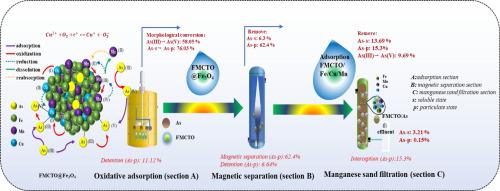FMCTO@Fe3O4在吸附-磁选-砂滤设备中去除饮用水中砷:砷去除效率与吸附剂利用率的权衡
IF 12.4
1区 环境科学与生态学
Q1 ENGINEERING, ENVIRONMENTAL
引用次数: 0
摘要
由于砷具有致癌性和高环境流动性,其在地下水环境中的污染广泛存在,并通过食物链不断威胁着人类的健康。吸附除砷技术因其简单、经济、高效而受到广泛关注。尽管有这些优点,但传统吸附方法中吸附剂与砷污染水分离困难,限制了其大规模应用的发展。合成了一种磁铁矿修饰的Fe-Mn-Cu三元氧化物吸附剂(FMCTO@Fe3O4),开发了一种基于吸附-磁选一体化安全装置的高效砷去除装置。通过动态试验优化反应堆设计参数,对其安全性和适用性进行了评价。x射线光电子能谱、x射线衍射和zeta电位结果表明FMCTO@Fe3O4具有较高的吸附氧化性能,截面中77%的As(III)被氧化为As(V)。As粒子(As-p)静电吸附在物料表面,在磁选段和锰砂过滤段的去除率为84%。在此过程中,从B段分离得到的FMCTO@Fe3O4表现出更强的吸附能力。具体来说,FMCTO@Fe3O4在使用2 ~ 3次后,达到了80%的As(tot)去除效率。B区功能区回收铁(99.24%)、铜(98.2%)、锰(98.6%),设备具有较高的稳定性和经济回收率。该装置在去除地下水砷方面具有广阔的应用前景,为饮用水安全保障提供理论支持和应用创新。本文章由计算机程序翻译,如有差异,请以英文原文为准。


As(III) removal from drinking water using FMCTO@Fe3O4 in the adsorption-magnetic separation-sand filtration equipment: Trade-off between As removal efficiency and adsorbent utilization rate
Due to the carcinogenicity and high environmental mobility of arsenic (As), its contamination in the groundwater environment is widespread, continuously threatening human health through the food chain. The adsorption technologies for As removal, which demonstrate simplicity and cost-effectiveness, have received much attention. Despite these merits, the difficult separation between adsorbent and As-contaminated water in traditional adsorption limited the development of large-scale applications. An adsorbent of Fe-Mn-Cu ternary oxide modified with magnetite (FMCTO@Fe3O4) was synthesized to develop a highly efficient As removal device based on an Adsorption-magnetic separation integrated safety device. Its safety and applicability were evaluated by optimizing the reactor design parameters using dynamic experiments. X-ray photoelectron spectroscopy, X-ray diffraction, and zeta potential results show that FMCTO@Fe3O4 has high adsorption and oxidation performance, in which 77 % of As(III) in the section was oxidized to As(V). As particle (As-p) electrostatically adsorbed to the surface of the material, with a removal efficiency of 84 % in the magnetic separation section and manganese sand filtration section. In this process, FMCTO@Fe3O4 isolated from magnetic separation section showed far stronger adsorption capacity. Specifically, FMCTO@Fe3O4, after being used 2 or 3 times, achieved an 80 % As(tot) removal efficiency. The section B functional area recycled Fe (99.24 %), Cu (98.2 %), and Mn (98.6 %), which demonstrated the equipment with higher stability and economic recovery. This device is promising in groundwater As removal, providing theoretical support and application innovation for drinking water safety and security.
求助全文
通过发布文献求助,成功后即可免费获取论文全文。
去求助
来源期刊

Water Research
环境科学-工程:环境
CiteScore
20.80
自引率
9.40%
发文量
1307
审稿时长
38 days
期刊介绍:
Water Research, along with its open access companion journal Water Research X, serves as a platform for publishing original research papers covering various aspects of the science and technology related to the anthropogenic water cycle, water quality, and its management worldwide. The audience targeted by the journal comprises biologists, chemical engineers, chemists, civil engineers, environmental engineers, limnologists, and microbiologists. The scope of the journal include:
•Treatment processes for water and wastewaters (municipal, agricultural, industrial, and on-site treatment), including resource recovery and residuals management;
•Urban hydrology including sewer systems, stormwater management, and green infrastructure;
•Drinking water treatment and distribution;
•Potable and non-potable water reuse;
•Sanitation, public health, and risk assessment;
•Anaerobic digestion, solid and hazardous waste management, including source characterization and the effects and control of leachates and gaseous emissions;
•Contaminants (chemical, microbial, anthropogenic particles such as nanoparticles or microplastics) and related water quality sensing, monitoring, fate, and assessment;
•Anthropogenic impacts on inland, tidal, coastal and urban waters, focusing on surface and ground waters, and point and non-point sources of pollution;
•Environmental restoration, linked to surface water, groundwater and groundwater remediation;
•Analysis of the interfaces between sediments and water, and between water and atmosphere, focusing specifically on anthropogenic impacts;
•Mathematical modelling, systems analysis, machine learning, and beneficial use of big data related to the anthropogenic water cycle;
•Socio-economic, policy, and regulations studies.
 求助内容:
求助内容: 应助结果提醒方式:
应助结果提醒方式:


